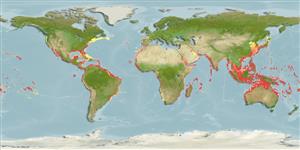Common names from other countries
分类 / Names
俗名 | 同种异名 | Catalog of Fishes(属, 种) | ITIS | CoL | WoRMS | Cloffa
Teleostei >
Carangiformes (Jacks)
鱸形目 (Jacks) >
Carangidae (Jacks and pompanos) > Caranginae
Etymology: Selar: A Malay vernacular name, ikan selar.
More on author: Bloch.
Environment: milieu / climate zone / depth range / distribution range
生态学
海洋 礁区鱼类; 深度上下限 0 - 170 m (Ref. 9283), usually 2 - 10 m (Ref. 40849). 亞熱帶的; 47°N - 31°S, 180°W - 180°E
Circumtropical. Indo-Pacific: East Africa (Ref. 3287) to Rapa, north to southern Japan and the Hawaiian Islands, south to New Caledonia. Eastern Pacific: Mexico to Peru, including the Galapagos Islands (Ref. 5530). Western Atlantic: Nova Scotia, Canada and Bermuda through the Gulf of Mexico and the Caribbean to to São Paulo (Ref. 47377), Brazil. Eastern Atlantic: Cape Verde to southern Angola (Ref. 7097).
Circumtropical。 印度-太平洋: 到拉帕島的東非 (參考文獻 3287), 北至日本南部與夏威夷群島, 南至新加勒多尼亞。 東太平洋: 墨西哥到祕魯, 包括加拉巴哥群島.(參考文獻 5530) 西大西洋: 對聖保羅 (參考文獻 47377) 巴西的加拿大的新斯科舍省,百慕達群島與里約熱內盧 (參考文獻 1602); 在巴哈馬,墨西哥灣與加勒比海各處.(參考文獻 9626,26938) 東大西洋: 維德角到安哥拉南部.(參考文獻 7097)
Length at first maturity / 大小 / 重量 / 年龄
Maturity: Lm 17.7 range ? - ? cm
Max length : 70.0 cm TL 雄鱼/尚未辨别雌雄; (Ref. 48635); 最大年龄: 3.00 年 (Ref. 104735)
背棘 (总数) : 9; 背的软条 (总数) : 24 - 27; 臀棘: 3; 臀鳍软条: 21 - 23.
细长的身体与略微扁长形的; 脂眼睑发展得很好的, 几乎包含的整个眼; 肩肢带骨 (匙骨) 的边缘具有一个腹的沟,被紧邻大约沟与另外比较小的近背部边缘的一个大的乳突; 侧线有 29 到 42个鳞甲; 低分支第一个鳃弓有 27 到 31个鳃耙.(参考文献 55763) 色彩铁蓝色的到蓝绿色的背面, 颜色变化成腹侧白色的; 侧面的黄色斑纹有时候有。 鳃裂的下缘具有一个深的沟,一个大的乳突紧接在它与一个比较小的上近的上缘。 鳃盖有黑色的斑点。 笔直地部份侧线有 0-11个鳞片与 29-42个鳞甲。 最初 2個臀鰭硬棘分離了; 胸鰭鐮刀狀的。
Adults prefer clear oceanic waters around islands to neritic waters (Ref. 5217). Occasionally in turbid waters (Ref. 9283). Pelagic (Ref. 58302). Individuals travel in compact groups of hundreds of thousands of fish. Mainly nocturnal in habit, they disperse at night to feed on small shrimps, benthic invertebrates, and forams when inshore, and zooplankton and fish larvae when offshore (Ref. 9283, 90102). Marketed fresh and salted or dried (Ref. 9283). Reported to reach 70 cm TL (Ref. 48635).
对浅海的水域岛的周围偏爱清澈的大洋性水域。 (参考文献 5217) 偶见于浑浊的水域。 (参考文献 9283) 主要夜行。 吃小的虾,底栖的无脊椎动物与有孔动物当沿海地区 , 与浮游动物与仔鱼当外海的时候。 以紧密群体的数十万计的鱼移动。 在市场上销售生鲜地了与盐腌或乾燥的.(参考文献 9283)
Circumtropical。 印度-太平洋: 到拉帕島的東非 (參考文獻 3287), 北至日本南部與夏威夷群島, 南至新加勒多尼亞。 東太平洋: 墨西哥到祕魯, 包括加拉巴哥群島.(參考文獻 5530) 西大西洋: 對聖保羅 (參考文獻 47377) 巴西的加拿大的新斯科舍省,百慕達群島與里約熱內盧 (參考文獻 1602); 在巴哈馬,墨西哥灣與加勒比海各處.(參考文獻 9626,26938) 東大西洋: 維德角到安哥拉南部.(參考文獻 7097)
Smith-Vaniz, W.F., 1995. Carangidae. Jureles, pámpanos, cojinúas, zapateros, cocineros, casabes, macarelas, chicharros, jorobados, medregales, pez pilota. p. 940-986. In W. Fischer, F. Krupp, W. Schneider, C. Sommer, K.E. Carpenter and V. Niem (eds.) Guia FAO para Identification de Especies para lo Fines de la Pesca. Pacifico Centro-Oriental. 3 Vols. FAO, Rome. (Ref. 9283)
CITES (Ref. 128078)
Not Evaluated
人类利用
渔业: 高经济性; 游钓鱼种: 是的; 诱饵: usually
工具
特别资料
下载 XML
网络资源
Estimates based on models
Preferred temperature (Ref.
115969): 20 - 29.2, mean 27.9 (based on 6848 cells).
Phylogenetic diversity index (Ref.
82804): PD
50 = 0.7500 [Uniqueness, from 0.5 = low to 2.0 = high].
Bayesian length-weight: a=0.01349 (0.01201 - 0.01516), b=2.98 (2.95 - 3.01), in cm Total Length, based on LWR estimates for this species (Ref.
93245).
营养阶层 (Ref.
69278): 3.8 ±0.2 se; based on diet studies.
回复力 (Ref.
120179): 高度, 族群倍增时间少于 15个月 (K=0.6-0.9).
Prior r = 1.19, 95% CL = 0.79 - 1.79, Based on 8 data-limited stock assessments.
Fishing Vulnerability (Ref.
59153): Low vulnerability (25 of 100).
Climate Vulnerability (Ref.
125649): High vulnerability (60 of 100).
